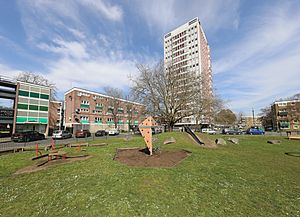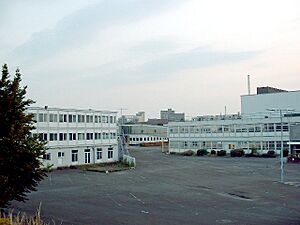Northam, Southampton facts for kids
Quick facts for kids Northam |
|
|---|---|
 The Millbank Tower dominates the Northam skyline |
|
| Unitary authority | |
| Ceremonial county | |
| Region | |
| Country | England |
| Sovereign state | United Kingdom |
| Post town | SOUTHAMPTON |
| Postcode district | SO14 |
| Dialling code | 023 |
| Police | Hampshire |
| Fire | Hampshire |
| Ambulance | South Central |
| EU Parliament | South East England |
| UK Parliament |
|
Northam is a lively area in Southampton, Hampshire, located on the west bank of the River Itchen. It shares its borders with places like St Mary's, Bitterne, and Bevois Valley. You'll find new apartment buildings in the Chapel area, close to St Mary's.
A main road, the A3024 road, goes through Northam and crosses the Northam Bridge. This bridge connects Northam to Bitterne through Bitterne Manor. Even though it's called St Mary's Stadium, the home of Southampton F.C. (a famous football club) is actually located right here in Northam!
Contents
Northam's Past: A Look Back
Northam has a long and interesting history. In 1549, a decision was made that people living in Northam did not have rights to use Southampton Common. A map from 1560 shows a building where the Old Farmhouse pub stands today. Some bricks in the building even show the date 1611.
Shipbuilding and Waterways
A shipyard was started in Northam in 1693 by John Winter. He bought the land specifically to build ships there.
Later, in the 1790s, a part of the Salisbury and Southampton Canal was built in Northam. However, it was closed down just ten years later. The first Northam Road Bridge, made of wood, was built in 1796. During the Victorian era, many of Southampton's factories and businesses were located along the River Itchen.
Early Industry and Ships
From 1840, Northam was home to the Northam iron works, owned by Summers and Day. The very first ship built from iron on the River Itchen was launched from their yard on October 14, 1840. It was named Pride of the Waters, but later called Ruby. Soon after, by 1842, another shipyard was opened by John Rubie, just a bit further down the river.
In the early 1900s, big steamship companies like the White Star Line and the Cunard Line were major employers in Northam. A sad event in 1912 saw over 350 Northam residents die when the RMS Titanic sank. This tragedy left 125 children from just one school without parents.
Modern Changes and Buildings
The old wooden road bridge was replaced and made stronger in the mid-1900s, reopening in 1954. In 1957, Southampton city council started building new homes, including the 16-story Millbank House tower. This tower opened in 1960 and was updated in 1988 with new outer walls and enclosed balconies. The rest of the housing estate was finished by 1965.
In 1965, more work was done on the A3024 dual carriageway that runs through Northam. This was to match the opening of the M27 motorway.
Railways and Tramways in Northam
Northam has a long history with trains and trams.
Early Train Lines
The London & Southampton Railway reached Northam in 1839. For a few months, the train line ended at a temporary station in Northam. This was until the main Southampton Terminus station was completed.
To reach Southampton Terminus, the railway line had to cross Northam Road. At first, there was a level crossing where the road and railway met at the same level. But after a disagreement, the railway agreed to build a bridge to carry the road over the tracks. This brick bridge started being built before 1840.
In 1858, a new connection was added, linking the line to what is now Southampton Central railway station. This meant the bridge had to be made longer with a cast iron section. The railway junction was changed in 1902 to make the curve less sharp, which had limited trains to a slow 7 miles per hour. The curve was made even smoother in 1980.
Tramways and Stations
The first part of the Northam Quay tramway was built around the early 1840s. This first line connected Northam Quay to industrial areas. Over the years, the tramway connected to other factories and even the main railway line.
Northam got its own railway station, Northam railway station, which opened on December 1, 1872.
The London & South Western Railway opened a large train maintenance depot in Northam in 1840. This was the main place for servicing locomotives in the area until 1903. A new depot was then built at Eastleigh, and the Northam site became a goods yard for storing items.
Work to replace the bridges carrying Northam Road over the railway began in 1907. The new steel bridge, supported by strong metal frames, opened in 1908.
Northam station closed on September 3, 1966, and was taken down by the end of that decade. The Northam Quay tramway also closed in 1984.
In 2001, South West Trains chose Northam for a new train maintenance facility. This was built on the site of the old goods yard. The Northam Carriage Servicing Depot was built by Turner & Townsend and opened in 2003.
Places of Worship in Northam
Northam has a few important religious buildings.
The Augustine Centre was originally a Church of England church. It later became home to the Northam Pentecostal Church. The church was built between 1881 and 1884. In the early 1980s, it was bought by Riverside Family Church and given its new name. This building is a Grade II listed building, which means it's an important historical structure.
Northam Primitive Methodist Church opened in 1874. The first wedding there was in September 1911, and a Sunday school was added in the late 1920s. By 2022, the church was no longer in use, and there were plans to turn it into homes.
Television Centre, Southampton
Northam was once home to the Television Centre, Southampton. This was where TV companies like Meridian Broadcasting, TVS, and Southern Television operated. Later, Meridian moved its operations to Whiteley.
Besides the regional news show Meridian Tonight, these studios were also where the very first series of the popular game show Catchphrase was made. They also handled the broadcasting for other TV regions and even Saturday morning children's programmes like The Saturday Banana.
An attempt to rebuild the site failed in 2009. In 2014, new plans were announced to turn the site into a residential area with homes. Building started in 2016, and by late 2023, two apartment blocks were finished, and a third was started.



